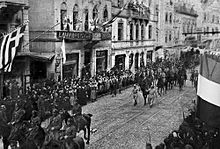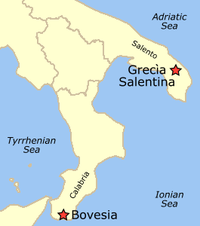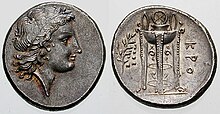Enosis

Enosis (
A widely known example of enosis is the movement within Greek Cypriots for a union of Cyprus with Greece. The idea of enosis in British-ruled Cyprus became associated with the campaign for Cypriot self-determination, especially among the island's Greek Cypriot majority. However, many Turkish Cypriots opposed enosis without taksim, the partitioning of the island between Greek Cypriots and Turkish Cypriots. In 1960, the Republic of Cyprus was born, resulting in neither enosis nor taksim.
Around then,
History

The boundaries of the
The Ionian Islands had been placed under British protection as a result of the Treaty of Paris in 1815,[5] but once Greek independence had been established after 1830, the islanders began to resent foreign colonial rule and to press for enosis. Britain transferred the islands to Greece in 1864.
An unsuccessful Greek uprising in
In 1821, several parts of
After World War I, Greece began the
Most of the
The
In modern times, apart from Cyprus, the call for enosis is most often heard among part of the Greek community living in southern Albania.[11]
Cyprus
Inception
In 1828, the first President of
The death of Limassol–
Britain offered to cede the island to Greece in 1915 in return for Greece joining the
The enosis movement was the outgrowth of nationalist awareness among Greek Cypriots (around 80%[21] between 1882 and 1960), coupled with the growth of the anticolonial movement throughout the British Empire after World War II. In fact, the anticolonial movement in Cyprus was identified with the enosist movement, which was, in the minds of the Hellenic population of Cyprus, the only natural outcome of the liberation of Cypriots from Ottoman rule and later British rule.[citation needed] A string of British proposals for local autonomy under continued British suzerainty were roundly rejected.[citation needed]
1940s and 1950s
In the 1950s, the influence of the Greek Orthodox Church of Cyprus over the education system resulted in the ideas of Greek nationalism and enosis being promoted in Greek Cypriot schools. School textbooks portrayed Turks as the enemies of Greeks, and students took an oath of allegiance to the Greek flag. The British authorities attempted to counter that by publishing an intercommunal periodical for students and by suspending the Cyprus Scouts Association for its Greek nationalist tendencies.[22]
In December 1949, the Cypriot Orthodox Church asked the British colonial government to put the enosis question to a referendum on the basis of the right of the Cypriots' for self-determination. Even though the British had been an ally of Greece during World War II and had recently supported the Greek government during the Greek Civil War, the British colonial government refused.
In 1950, Archbishop
After the referendum, a Greek Cypriot deputation visited Greece, Britain and the United Nations to make its case, and Turkish Cypriots and student and youth organisations in Turkey protested the plebiscite. In the event, neither Britain nor the UN was persuaded to support enosis.[28] In 1951, a report was produced by the British government's Smaller Territories Enquiry into the future of the British Empire's smaller territories, including Cyprus. It concluded that Cyprus should never be independent from Britain. That view was strengthened by Britain's withdrawal of its Suez Canal base in 1954 and the transfer of its Middle East Headquarters to Cyprus.[17] In 1954, Greece made its first formal request to the UN for the implementation of "the principle of equal rights and of self-determination of the peoples", in the case of the Cypriot population. Until 1958, four other requests to the United Nations were made unsuccessfully by the Greek government.[29]
In 1955, the resistance organisation
After independence
The idea of union with Greece was not immediately abandoned, however. During the campaign for the
In the early 1970s, the idea of enosis remained attractive to many Greek Cypriots, and Greek Cypriot students condemned Makarios's support for an independent unitary state. In 1971 the pro-enosis paramilitary group
The events of 1974 caused the geographic partition of Cyprus and massive
In 2017 the
North Epirus

The history of Northern Epirus in the period 1913-1921 was marked by the desire of the local Greek element for union with the Kingdom of Greece, as well as the redemptive desire of Greek politics to annex this region, which was eventually awarded to the Albanian Principality.
During the First Balkan War, Northern Epirus, which hosted a significant minority of Orthodox speakers who spoke either Greek or Albanian, was, at the same time as South Epirus, under the control of the Greek army, which had previously repelled Ottoman forces. Greece wanted to annex these territories. However, Italy and Austria-Hungary opposed this, while the Treaty of Florence of 1913 granted Northern Epirus to Albania's newly formed Principality, the majority of whose inhabitants were Muslims. Thus, the Greek army withdrew from the area, but the Christians of Epirus, denying the international situation, decided, with the secret support of the Greek state, to create an autonomous regime, based in Argyrokastro (Albanian: Gjirokastër).
Given Albania's political instability, the autonomy of Northern Epirus was finally ratified by the Great Powers with the signing of the Protocol of Corfu on May 17, 1914. The agreement did recognize the special status of the Epirotes and their right to self-determination. under the legal authority of Albania. However, the agreement never materialized, as the Albanian government collapsed in August, and Prince William of Wied, who was appointed leader of the country in February, returned to Germany in September.
Shortly after the outbreak of World War I, in October 1914, the Kingdom of Greece recaptured the region. However, the ambiguous attitude of the Central Powers on Greek issues during the Great War, led France and Italy to the joint occupation of Epirus in September 1916. At the end of World War I, however, the Agreement of Tittoni with Venizelos foresaw the annexation of the region to Greece. Eventually, Greece's military involvement with Mustafa Kemal's Turkey worked in the interest of Albania, which permanently annexed the region on 9 November 1920.
Smyrna
This section may contain an excessive amount of intricate detail that may interest only a particular audience. |


At the end of World War I (1914–1918), attention of the Allied Powers (Entente Powers) focused on the partition of the territory of the Ottoman Empire. As part of the Treaty of London (1915), by which Italy left the Triple Alliance (with Germany and Austria-Hungary) and joined France, Great Britain and Russia in the Triple Entente, Italy was promised the Dodecanese and, if the partition of the Ottoman Empire were to occur, land in Anatolia including Antalya and surrounding provinces presumably including Smyrna.[33] But in later 1915, as an inducement to enter the war, British Foreign Secretary Edward Grey in private discussion with Eleftherios Venizelos, the Greek Prime Minister at the time, promised large parts of the Anatolian coast to Greece, including Smyrna.[33] Venizelos resigned from his position shortly after this communication, but when he had formally returned to power in June 1917, Greece entered the war on the side of the Entente.[34]
On 30 October 1918, the
In April 1919, the Italians landed and took over Antalya and began showing signs of moving troops towards Smyrna.[35] During the negotiations at about the same time, the Italian delegation walked out when it became clear that Fiume (Rijeka) would not be given to them in the peace outcome.[33] Lloyd George saw an opportunity to break the impasse over Smyrna with the absence of the Italian delegation and, according to Jensen, he "concocted a report that an armed uprising of Turkish guerrillas in the Smyrna area was seriously endangering the Greek and other Christian minorities."[33] Both to protect local Christians and also to limit increasing Italian action in Anatolia, French Prime Minister Georges Clemenceau and U.S. President Woodrow Wilson supported a Greek military occupation of Smyrna.[33] Although Smyrna would be occupied by Greek troops, authorized by the Allies, the Allies did not agree that Greece would take sovereignty over the territory until further negotiations settled this issue.[33] The Italian delegation acquiesced to this outcome and the Greek occupation was authorized.
Turkish capture of Smyrna
Greek troops evacuated Smyrna on 9 September 1922 and a small allied force of British entered the city to prevent looting and violence. The next day, Mustafa Kemal, leading a number of troops, entered the city and was greeted by enthusiastic Turkish crowds.
The evacuation of Smyrna by Greek troops ended most of the large scale fighting in the Greco-Turkish war which was formally ended with an Armistice and a final treaty on 24 July 1923 with the Treaty of Lausanne. Much of the Greek population was included in the 1923 population exchange between Greece and Turkey resulting in migration to Greece and elsewhere.[36]
Ionian Islands
Under the
A few years later
On 26 November 1850, the Radical MP John Detoratos Typaldos proposed in the Ionian parliament the resolution for the enosis of the Ionian Islands with Greece which was signed by Gerasimos Livadas, Nadalis Domeneginis, George Typaldos, Frangiskos Domeneginis, Ilias Zervos Iakovatos, Iosif Momferatos, Telemachus Paizis, Ioannis Typaldos, Aggelos Sigouros-Dessyllas, Christodoulos Tofanis. In 1862, the party split into two factions, the "United Radical Party" and the "Real Radical Party". During the period of British rule, William Ewart Gladstone visited the islands and recommended their reunion with Greece, to the chagrin of the British government.[citation needed]
On 29 March 1864, representatives of Great Britain, Greece, France, and Russia signed the Treaty of London, pledging the transfer of sovereignty to Greece upon ratification; this was meant to bolster the reign of the newly installed King George I of Greece. Thus, on 28 May, by proclamation of the Lord High Commissioner, the Ionian Islands were united with Greece.[43]
Southern Italy
Since the beginning of the 2010s, an online social movement has been launched to awaken the Greek consciousness of the inhabitants of Southern Italy and also to express an opinion that highlights the desire of a part of the inhabitants of the south for secession from the state of Italy, its union with the Hellenism of the Mediterranean Sea (and re-establishment of Magna Graecia and the Kingdom of the Two Sicilies).[44]

Through pages mainly on Facebook, historical issues are highlighted that have more to do with the Greek presence in Italy that begins with the migration of the Greek diaspora in the 8th century BC., the linguistic minority, known as Griko in Calabria, Apulia and Messina, the modern day Greeks of Italy and in general the inhabitants of the south who call themselves Great-Greeks (MagnoGreci).[45]

The largest Facebook page highlighting the specific issues called "Stato Magna Grecia - Due Sicilie", has over 270,000 followers, mainly Italians but also several Greeks and Griko, expressing the need for the secession of Sicily and the whole of Southern Italy, the so-called Mezzogiorno and its enosis with Greece and Cyprus. This page and other pages based in Italy highlight the achievements of ancient Magna Graecia and the Kingdom of the Two Sicilies as well as the close relations that the people of Southern Italy have with Greece.[46]

According to the administrators, the unification of Italy, in which
On a political level, the administrators of the said Magna Graecia - Two Sicilies pages urged followers during the 2023 national elections in Greece to vote for political parties supporting the demand for independence of South Italy and union with Greece. [46]
According to Italian media, the Italian political party "Insorgenza" led by Luigi Lista and based in Naples presents itself as a movement that represents, among others, the Greek identity of Southern Italy. [48]
The association "Comitato provincia della Magna Graecia" chaired by Domenico Mazza was created with the aim of promoting the union of all the regions of South Italy into a new separate great region of Italy and developing a stronger connection with Greece.[49]
In Greece, the far-right party "Hellenic world empire" (Ελληνική Κοσμοκρατορία), which officially seeks the secession of the Italian south, participated in the 2019 European elections in a joint descent with the Popular Orthodox Rally party and the Patriotic Radical Union party of the independent MEP, elected with the Golden Dawn of Eleftherios Synadinos gathered the 1.23%. [50]

According to Greek media, the inhabitants of South Italy already have their own flag with the emblem of the ancient greek tripod symbolizing the oracle of Delphi by Pythia that determined where the Greek colonies should be established in Italy, as well as an informal national anthem, created by the Greek soprano Sonia Theodoridou. [44] [51]
See also
- Miatsum
- Taksim
- Greek nationalism
- Anti-Turkism
Notes
- ^ "Ethnic Greek minority groups had encouraged their members to boycott the census, affecting measurements of the Greek ethnic minority and membership in the Greek Orthodox Church."[31]
- ^ "Portions of the census dealing with religion and ethnicity have grabbed much of the attention, but entire parts of the census might not have been conducted according to the best international practices, Albanian media reports..."[32]
References
- ^ "On This Day In History: Independence Of Greece Is Recognized By The Treaty Of London – On May 7, 1832". Ancient Pages. 7 May 2016.
- ISBN 9781315297910.
- ISBN 9780761478782.
- ISBN 9780312299132.
- ISBN 9780198723059.
- ISBN 9783515076876.
- ISBN 9781576078006.
- ^ ISBN 9781903900789.
- ISBN 978-1-85109-420-2. Retrieved 26 January 2011.
- ISBN 978-0-7146-1974-3.
- ISBN 9780765605283.
- ISBN 1-85043-580-4" "In 1828, modern Greece's first president, Count Kapodistria, called for union of Cyprus with Greece, and various minor uprising took place.
- ISBN 9780810862982.
- ^ Mirbagheri (2009), p. 57.
- ^ Papapolyviou 1996, pp. 186–193, 340.
- ^ Klapsis 2013, pp. 765–767.
- ^ ISBN 9780198702436.
- ISBN 9783110203240.
- ISBN 9781135294144.
- ^ ISBN 9781857431322.
- ^ "Cyprus - Population". Country-data.com. Retrieved 2011-01-05.
- ISBN 978-1139505444.
- ISBN 9780754660590.
- ^ Goktepe 2013, pp. 92–3.
- ^ Zypern, 22. Januar 1950 : Anschluss an Griechenland Direct Democracy
- ^ "ΕΝΩΤΙΚΟ ΔΗΜΟΨΗΦΙΣΜΑ 15-22/1/1950 (in Greek, includes image of a signature page)". Cyprus.novopress.info. Archived from the original on 2011-07-21. Retrieved 2011-01-05.
- ^ "Κύπρος: το ενωτικό δημοψήφισμα που έγινε με υπογραφές (in Greek)". Hellas.org. 1967-04-21. Archived from the original on 3 March 2001. Retrieved 2011-01-05.
- ^ a b Goktepe 2013, p. 93.
- ^ Emis i Ellines- Polemiki istoria tis Synhronis Elladas ("Greeks- War History of Modern Greece"), Skai Vivlio press, 2008, chapter by nikos Papanastasiou "The Cypriot Issue", p. 125, 142
- ^ "Turkey slams Greek Cyprus' Enosis move". Hürriyet Daily News. 15 February 2017. Retrieved 10 January 2018.
- ^ "International Religious Freedom Report for 2014: Albania" (PDF). www.state.gov. United States, Department of State. p. 5. Retrieved 20 October 2015.
- ^ "Final census findings lead to concerns over accuracy". Tirana Times. 19 December 2012. Archived from the original on 2012-12-26.
- ^ S2CID 163086095.
- S2CID 144330013.
- ^ S2CID 159577598.
- ^ ISBN 9781850653684.
- ISBN 9789027227119.
- ISBN 9781134259588. Retrieved 23 February 2014.
Kemal's triumphant entry into Smyrna... as Greek and Armenian inhabitants were raped, mutilated, and murdered.
- ISBN 9780195323344. Retrieved 23 February 2014.
As the refugees crowded into the city, massacres, rape and looting, mainly but not exclusively by the irregulars, became the unspoken order of the day... Finally, the streets and houses of Smyrna were soaked in petrol... and on 13 September the city was set alight.
- S2CID 153449331.
- ISBN 0-8047-0296-9.
- ^ "The English in the Ionian Islands". www.ionion.com. Retrieved 25 February 2024.
- ^ Hertslet, Edward. The map of Europe by treaty (PDF). p. 1609. Retrieved 21 July 2006.
- ^ a b "Οι κάτοικοι της Νότιας Ιταλίας θέλουν να (ξανα)γίνουν Μεγάλη Ελλάδα!". 14 July 2023.
- ^ "Greek MFA: Greek community in Italy". Archived from the original on July 17, 2006. Retrieved April 4, 2008.
- ^ a b "Το ανυπότακτο «χωριό» στο Facebook που ονειρεύεται την ένωση Ιταλίας και Ελλάδας". 22 July 2023.
- ^ A. Leogrande (6 July 2017). "Neoborbonici a cinque stelle". Corriere del Mezzogiorno.
- ^ "Nasce il movimento "Insorgenza"". 20 December 2022.
- ^ "Il Comitato per la Baia della Magna Graecia: Un progetto di rinascita territoriale". 30 September 2023.
- ^ "Έπεσαν οι τελικές "υπογραφές" για την κοινή πορεία του Γ. Καρατζαφέρη και του Ελ. Συναδινού στις Ευρωεκλογές". 21 April 2019. Retrieved 25 February 2024.
- ^ "Στη Νάπολη ο νέος Ύμνος της Μεγάλης Ελλάδας σε σύνθεση Σόνιας Θεοδωρίδου (27/5/23) - Verianet". 26 May 2023.
Sources
- Klapsis, Antonis (2009). "Between the Hammer and the Anvil. The Cyprus Question and the Greek Foreign Policy from the Treaty of Lausanne to the 1931 Revolt". Modern Greek Studies Yearbook. 24. University of Minnesota: 127–140. Retrieved 26 May 2017.
- Klapsis, Antonis (2013). "The Strategic Importance of Cyprus and the Prospect of Union with Greece, 1919–1931: The Greek Perspective". The Journal of Imperial and Commonwealth History. 41 (5): 765–782. S2CID 161803453.
- Papapolyviou, Petros (1996). Η Κύπρος και οι Βαλκανικοί Πόλεμοι: Συμβολή στην Ιστορία του Κυπριακού Εθελοντισμού [Cyprus and the Balkan Wars: A Contribution to the History of Cypriot Volunteerism] (Doctoral Dissertation) (in Greek). Aristotle University of Thessaloniki. pp. 1–407. hdl:10442/hedi/8976. Retrieved 6 September 2017.


